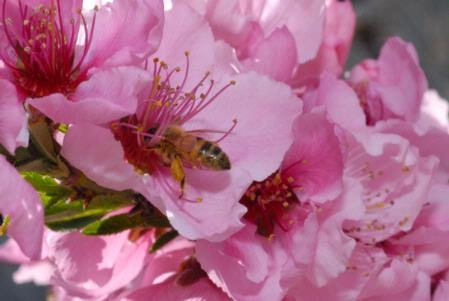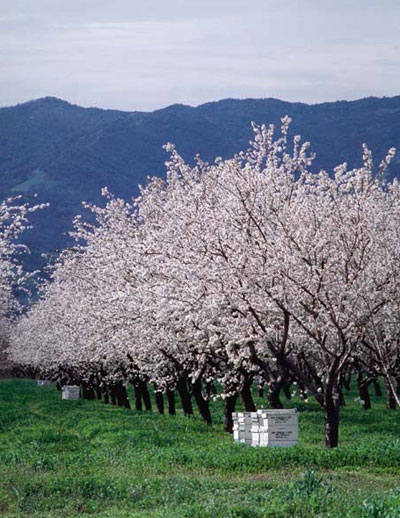Posts Tagged: Almonds
A couple of brief takes on bees
The KQED blog "News Fix" included a quick update yesterday about the California deep freeze that fizzled.
"It didn't snow in San Francisco — not really — or anywhere else near sea level late last week. Boo hoo. Let's get over it," wrote Dan Brekke.
But it was cold, so Brekke spoke to UC Cooperative Extension farm advisor Joe Connell about the effect of the cool February temperatures on California's almond crop.
Honeybees don’t like to fly in rain or freezing temperatures, Connell told him, so almond pollination has been delayed.
In other bee news, Southwest Airlines in-flight magazine Spirit highlighted a surprising fact: A bee produces just one-twelfth of a teaspoon of honey in its lifetime.
Each worker bee will fly 37,400 miles from flower to flower gathering nectar for that tiny bit of sweetener.
The queenbee's role was detailed by UC Davis honeybee expert Eric Mussen: “While the queen lays more than 1,000 eggs a day, other bees are busy feeding her, guarding the hive, and fanning the nectar with their wings to extract moisture, turning it into honey.”

A honeybee in a nectarine blossom.
Newspaper turns to UCCE for commentary on almond bloom
Even though the earliest almonds are already starting to bloom, this week's rain storms don't spell ruin for California farmers, according to UC Cooperative Extension farm advisor Joe Connell.
Connell shared his thoughts about bloom with reporter Heather Hacking of the Chico Enterprise Record. He said he has 80 years of bloom data in his office, and the date of first bloom is anywhere from the last week in January to the first week of March.
Because bees were in almond orchards last week, before the rain, the pollen gathered will help strengthen hives and prepare the bees for the work of the main almond bloom, the farm advisor said.
If the storms bring hail, however, it can disastrous for growers. Hail was reported in some areas Wednesday, which is not good, Connell told the reporter. The hail can damage open flowers and knock down nutlets; cold temperatures can cause frost damage.

Almond bloom is getting underway in California.
2010 was an excellent year for almonds
California almonds harvested in 2010 are expected to amount to 1.65 billion pounds or more, according to an article by Associated Press reporter Jeff Nachtigal. The story was picked up by many national publications, including the New York Times and the CBS News website.
The sizable almond crop is being met with strong worldwide demand and relatively high prices.
"The nut crops in general are looking good in California," UC farm advisor emeritus John Edstrom was quoted in the story.
UC Davis Cooperative Extension almond specialist Bruce Lampinen told the reporter that improved agricultural techniques used by California's 6,000 almond growers - such as planting trees closer together, cutting back on pruning and knocking off "mummies" during the winter to control navel orangeworm - have helped boost production.
But, the almond industry is not without its challenges.
- UC Davis entomologist Eric Mussen told the reporter that farmers are still concerned about major honeybee die-offs, which have doubled the cost of renting bees for pollination in the past five years.
- Water shortages are also a concern for some producers, according to Almond Board chair Mike Mason.
California almond growers produce 100 percent of the U.S. crop, supplying 100 percent of the domestic market, and 80 percent of the world market, said an Western Farm Press article about the bumper almond crop.

Improved almond production techniques have helped grow the industry.
Farm advisor hails self-pollinating almond
A self-pollinating almond variety under study at the USDA's research facility in Parlier would relieve farmers of costly annual bee rental to pollinate their trees, according to an article in Saturday's Fresno Bee.
"That is like the Holy Grail," UC Cooperative Extension farm advisor Roger Duncan told Bee reporter Robert Rodriguez.
"You can feel that hairiness with your tongue," the release quoted USDA geneticist Craig Ledbetter. “That can turn off U.S. almond consumers, who are used to the smooth texture of Nonpareils."
Ledbetter used Tuono as the male parent in conventional hybridizations with California almond cultivars and selections. In 2008, he brought eight promising self-pollinating selections to the California Almond Board for evaluation of taste and appearance. Testers rated the nuts comparable to Nonpareils, the USDA release said.
ABC Action News in Fresno also took on the story. It said Ledbetter began his work with self-pollinating almond trees 17 years ago out of fears Africanized bees could kill off local hives.
"It was out of those concerns we really started the program," Ledbetter told reporter Dale Yurong. "It's ironic that a different bee problem (Colony Collapse Disorder) came up."

Bee hives in a California almond orchard.
Protecting Our Pollinators
It's not too early to start thinking about NPW.NPW? National Pollinator Week. The fourth annual National Pollinator Week, set June 21-27, is a time...

Almond Tree at the Laidlaw Facility

Honing In

Buds 'n Blossoms

Close-Up

